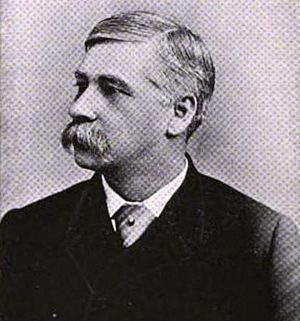Charles T. Saxton facts for kids
Charles Terry Saxton (born July 2, 1846, in Clyde, New York, died October 23, 1903, in Rochester, New York) was an American lawyer and a politician from New York. He was a member of the Republican Party.
Contents
Early Life and Military Service
Charles Saxton was the son of Daniel and Eliza A. Saxton. He went to school at Clyde High School. As a young man, he was part of the Young Men's Debating Club in Cortland.
In 1861, when he was only 15, Charles Saxton joined the 19th Regiment of New York Volunteers. He fought in the American Civil War and ended his service as a major. He took part in important battles like the Red River campaign and the Battle of Port Hudson.
Becoming a Lawyer and Politician
After the war, Charles Saxton studied law and became a lawyer. He also served his community as a Justice of the Peace and was the President of the Village of Clyde.
He was involved in national politics too. He was a representative at the 1884 Republican National Convention and the 1900 Republican National Convention. These conventions are where political parties choose their candidates for president.
Working in the New York State Assembly
Charles Saxton was elected to the New York State Assembly for Wayne County from 1887 to 1889. In 1888, he became the leader of the Judiciary Committee. This committee helps create and review laws.
He worked hard to pass a new law called the Ballot Reform Bill. This bill aimed to make voting fairer and more secret. He managed to get the bill passed in both the Assembly and the Senate. However, the Governor at the time, David B. Hill, did not approve it. Charles Saxton tried again the next year, and the bill passed both houses again, but Governor Hill still vetoed it.
Serving in the New York State Senate
From 1890 to 1894, Charles Saxton was a member of the New York State Senate. In 1894, he became the President pro tempore, which meant he was a very important leader in the Senate.
In 1890, after making some changes to the Ballot Reform Bill based on the governor's concerns, he finally got it passed into law. This was a big success for him and for fair voting. In 1891, he was also given an honorary degree, called an LL.D., from Union College.
In 1892, Charles Saxton faced a challenge in the Senate. He disagreed with a plan to change how voting districts were set up. Because he refused to vote on a certain bill, he and two other senators were temporarily removed from the official list of members. However, a committee supported their position, and their names were put back on the list.
Lieutenant Governor and Judge
From 1895 to 1896, Charles Saxton served as the Lieutenant Governor of New York. He was elected with Levi P. Morton as governor. The Lieutenant Governor is like a vice-president for the state, ready to take over if the governor cannot serve.
After his time as Lieutenant Governor, on March 30, 1897, he was appointed as one of the first judges of the New York Court of Claims. This court handles legal claims against the state. He started his job on January 1, 1898, and was chosen as the Chief Judge. He continued to serve in this important role until his death.
Later Life
In late 1903, Charles Saxton's health began to fail. He went to Clifton Springs for treatment, but he did not get better. He then moved to a hospital in Rochester, where he passed away a week later on October 23, 1903.
See also
- List of New York Legislature members expelled or censured


